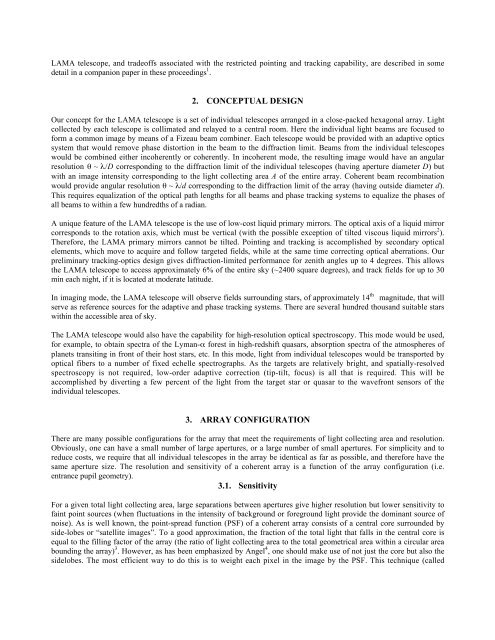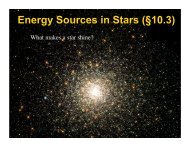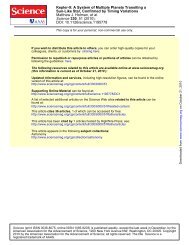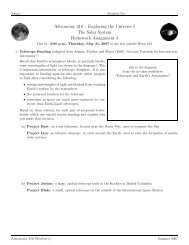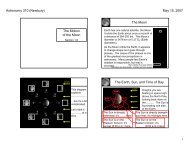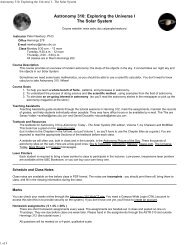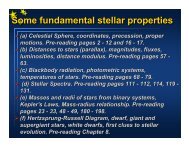Large Aperture Mirror Array (LAMA) - Astronomy and Astrophysics at ...
Large Aperture Mirror Array (LAMA) - Astronomy and Astrophysics at ...
Large Aperture Mirror Array (LAMA) - Astronomy and Astrophysics at ...
You also want an ePaper? Increase the reach of your titles
YUMPU automatically turns print PDFs into web optimized ePapers that Google loves.
<strong>LAMA</strong> telescope, <strong>and</strong> tradeoffs associ<strong>at</strong>ed with the restricted pointing <strong>and</strong> tracking capability, are described in somedetail in a companion paper in these proceedings 1 .2. CONCEPTUAL DESIGNOur concept for the <strong>LAMA</strong> telescope is a set of individual telescopes arranged in a close-packed hexagonal array. Lightcollected by each telescope is collim<strong>at</strong>ed <strong>and</strong> relayed to a central room. Here the individual light beams are focused toform a common image by means of a Fizeau beam combiner. Each telescope would be provided with an adaptive opticssystem th<strong>at</strong> would remove phase distortion in the beam to the diffraction limit. Beams from the individual telescopeswould be combined either incoherently or coherently. In incoherent mode, the resulting image would have an angularresolution q ~ l/D corresponding to the diffraction limit of the individual telescopes (having aperture diameter D) butwith an image intensity corresponding to the light collecting area A of the entire array. Coherent beam recombin<strong>at</strong>ionwould provide angular resolution q ~ l/d corresponding to the diffraction limit of the array (having outside diameter d).This requires equaliz<strong>at</strong>ion of the optical p<strong>at</strong>h lengths for all beams <strong>and</strong> phase tracking systems to equalize the phases ofall beams to within a few hundredths of a radian.A unique fe<strong>at</strong>ure of the <strong>LAMA</strong> telescope is the use of low-cost liquid primary mirrors. The optical axis of a liquid mirrorcorresponds to the rot<strong>at</strong>ion axis, which must be vertical (with the possible exception of tilted viscous liquid mirrors 2 ).Therefore, the <strong>LAMA</strong> primary mirrors cannot be tilted. Pointing <strong>and</strong> tracking is accomplished by secondary opticalelements, which move to acquire <strong>and</strong> follow targeted fields, while <strong>at</strong> the same time correcting optical aberr<strong>at</strong>ions. Ourpreliminary tracking-optics design gives diffraction-limited performance for zenith angles up to 4 degrees. This allowsthe <strong>LAMA</strong> telescope to access approxim<strong>at</strong>ely 6% of the entire sky (~2400 square degrees), <strong>and</strong> track fields for up to 30min each night, if it is loc<strong>at</strong>ed <strong>at</strong> moder<strong>at</strong>e l<strong>at</strong>itude.In imaging mode, the <strong>LAMA</strong> telescope will observe fields surrounding stars, of approxim<strong>at</strong>ely 14 th magnitude, th<strong>at</strong> willserve as reference sources for the adaptive <strong>and</strong> phase tracking systems. There are several hundred thous<strong>and</strong> suitable starswithin the accessible area of sky.The <strong>LAMA</strong> telescope would also have the capability for high-resolution optical spectroscopy. This mode would be used,for example, to obtain spectra of the Lyman-a forest in high-redshift quasars, absorption spectra of the <strong>at</strong>mospheres ofplanets transiting in front of their host stars, etc. In this mode, light from individual telescopes would be transported byoptical fibers to a number of fixed echelle spectrographs. As the targets are rel<strong>at</strong>ively bright, <strong>and</strong> sp<strong>at</strong>ially-resolvedspectroscopy is not required, low-order adaptive correction (tip-tilt, focus) is all th<strong>at</strong> is required. This will beaccomplished by diverting a few percent of the light from the target star or quasar to the wavefront sensors of theindividual telescopes.3. ARRAY CONFIGURATIONThere are many possible configur<strong>at</strong>ions for the array th<strong>at</strong> meet the requirements of light collecting area <strong>and</strong> resolution.Obviously, one can have a small number of large apertures, or a large number of small apertures. For simplicity <strong>and</strong> toreduce costs, we require th<strong>at</strong> all individual telescopes in the array be identical as far as possible, <strong>and</strong> therefore have thesame aperture size. The resolution <strong>and</strong> sensitivity of a coherent array is a function of the array configur<strong>at</strong>ion (i.e.entrance pupil geometry).3.1. SensitivityFor a given total light collecting area, large separ<strong>at</strong>ions between apertures give higher resolution but lower sensitivity tofaint point sources (when fluctu<strong>at</strong>ions in the intensity of background or foreground light provide the dominant source ofnoise). As is well known, the point-spread function (PSF) of a coherent array consists of a central core surrounded byside-lobes or “s<strong>at</strong>ellite images”. To a good approxim<strong>at</strong>ion, the fraction of the total light th<strong>at</strong> falls in the central core isequal to the filling factor of the array (the r<strong>at</strong>io of light collecting area to the total geometrical area within a circular areabounding the array) 3 . However, as has been emphasized by Angel 4 , one should make use of not just the core but also thesidelobes. The most efficient way to do this is to weight each pixel in the image by the PSF. This technique (called


